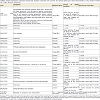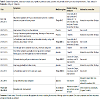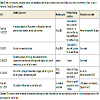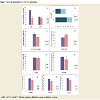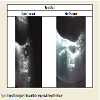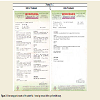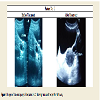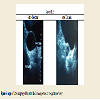Journal of Integrative Medicine & Therapy
Removal of Large Sized Ovarian Cysts in Three Patients by Administration of a Single Remedy, Thuja occidentalis: Hormonal Assay and Ultrasonographic Images
Debarsi Das1, Saiful Haque2, Asmita Samadder3, Saroj Kumar1 and Anisur Rahman Khuda-Bukhsh4*
- 1Mahesh Bhattacharyya Homeopathic Medical College and Hospital, Dumurjola, Howrah-711104, India
- 2Bengal Homeopathic Medical College and Hospital, Asansol, Burdwan-713301, India
- 3Department of Zoology, Dum Dum Motijheel College, Kolkata-700074, India
- 4Department of Zoology, University of Kalyani, Kalyani-741235, West Bengal, India
*Address for Correspondence: Anisur Rahman Khuda-Bukhsh, UGC Emeritus Fellow, Khuda-Bukhsh Homeopathic Benevolent Foundation, B-2/325, Husn-Ara Manzil, Kalyani-741235, West Bengal, India, Tel: +919331040032; E-mail: prof_arkb@yahoo.co.in
Citation: Das D, Saiful H, Asmita S, Saroj Kumar K, Rahman A, et al. Removal of Large Sized Ovarian Cysts in Three Patients by Administration of a Single Remedy, Thuja occidentalis: Hormonal Assay and Ultrasonographic Images. J Integrative Med Ther. 2016;3(1): 9.
Copyright © 2016 Das D, et al. This is an open access article distributed under the Creative Commons Attribution License, which permits unrestricted use, distribution, and reproduction in any medium, provided the original work is properly cited.
Journal of Integrative Medicine & Therapy | ISSN: 2378-1343 | Volume: 3, Issue: 1
Submission: 14 June, 2016 | Accepted: 29 June, 2016 | Published: 04 July, 2016
Reviewed & Approved by: Dr. Debasish Kundu, Khulna Homeopathic Medical College & Hospital, Khulna, Bangladesh
Abstract
Background: Ovarian cysts in women of reproductive age are now more commonly reported. These are generally associated with irregularities in menstruation, sometimes causing severe abdominal pains and large-sized cysts may even create problem associated with fertility, pregnancy and child birth. Although surgical intervention is taken recourse to by the orthodox treatment for removal of unwanted cysts, some patients try to avoid surgery and adopt homeopathic mode of treatment rather hesitantly because of limited research documentation in this field. In this paper, we intend to document three patients showing typical symptoms of Thuja occidentalis and how they were cured of their ailments, including the removal of large sized cysts in their left ovary with the administration of different potencies of the single medicine.
Methods: The homeopathic remedy, Thuja occidentalis, was found to be appropriate for all three patients on the basis of totality of symptoms as well as in consultation with the repertory. Potencies were chosen as per the homeopathic doctrine as suggested in the “Organon of Medicine”. The age of the patients varied from 16 years (youngest, unmarried) to 41 years (married), all of them having a large sized cyst in their left ovary apart from the associated menstrual problem and occasional pain in the abdomen.
Results: It took varying periods of time from 5 months to 30 months, for removal of all symptoms of ailment including the cyst. The case report is supported with trans-abdominal ultrasonographic evidence, before and after treatment. Data on certain hormonal assays as well as blood glucose level (fasting) of the patients prior to and after completion of the treatment have also been provided with a note on their possible implications as biomarkers, if any.
Conclusion: Homeopathic Thuja occidentalis could successfully remove ovarian cysts from all three patients and removed disease symptoms.
Keywords
Human; Ovarian cyst removal; Homeopathy; Thuja occidentalis; Ultrasonography; Hormones
Abbreviations
μg: Microgram; AM: After Medicine; BM: Before Medicine; DHEAS: Dehydroepiandrosterone Sulphate; dl: Decilitre; E2: Estradiol; F: Fasting; FSH: Follicle Stimulating Hormone; U: Units; LH: Leutinizing Hormones; mg: Milligram; ml: Millilitre; ng: Nanogram; pg: Picogram; PP: Post Prandial
Introduction
Cases of ovarian cysts, both single and multiple, are being increasingly reported in women of reproductive age [1,2]. An ovarian cyst is formed by the collection of fluid surrounded by a very thin wall within an ovary and any such follicle larger than about two centimetres qualifies for being termed as an ovarian cyst. Though most of them are small like a pea grain and benign or harmless in nature, some of them alarmingly grow in size and occasionally cause severe pain in the abdomen; patients bearing such large-sized cysts often complain of associated menstrual irregularities with excessive bleeding. In some patients, certain undesirable symptoms like dull aching or sudden sharp stitching pain in lower abdomen, pain during coition or even during bowel movements are also reported. If patients with these symptoms visit an orthodox medical practitioner or a surgeon, they are generally advised for surgical intervention to save the patient from further unwanted sufferings, which may even include a life threatening condition in stray cases. In general, patients and homeopathic practitioners feel equally unsure if homeopathic remedies can give them relief from their pains and sufferings, and can remove these cysts within a reasonable time span. This is partly because of lack of systemic research and publication of success/failure reports with proper and authentic documentation.
In this communication, we report three cases of successful removal of large sized cysts by the administration of a single remedy, Thuja occidentalis, selected on the basis of totality of symptoms [3] and in consultation with the respective Repertories of Kent (Tables 1-3) [4,5]. Apis mellifica, Belladonna, Lachesis, Arsenicum alb, Thuja occidentalis, Lycopodium clavatum, Calcarea carbonica etc. are the main drugs which are commonly used for treating cases of confirmed cysts, depending on specific guiding symptoms of the patients. Among the three patients under report, one patient had a “complex cyst containing debris and also having bulky left ovary”, which is considered as a relatively difficult case to cure. In another patient trans-abdominal ultrasonography (USG) revealed the occurrence of a big cyst (61.3 X 49.4 mm) with multiple thin septations. All the three patients reported pain in their left lower abdomen and had menstrual problem. In course of our extensive studies being carried out on patients with ovarian single cysts and multiple cysts [6,7] that needed use of some other homeopathic remedies based on totality of their symptoms, the speciality of these cases is that only a single homeopathic remedy in increasing potencies was used in all the three cases to eliminate cysts, strictly following the Hahnemannian concept of prescribing [3].
Materials and Methods
The common general symptoms of all the three patients as well as minor individual deviations have been summarized in (Tables 4-6) for the three patients. All of them had large single cysts located in their left ovary. They visited the clinic mainly with the complaint of nagging pain in the left abdominal region and some menstrual problem. They were first advised to perform trans-abdominal ultrasonography(USG) at the earliest which they complied with. USG reports confirmed presence of large sized cysts in all of them (Figures 1-6).
Discussion
In the present study, all three patients showing guiding symptoms of Thuja occidentalis were cured by the use of different potencies of the single remedy, but the time taken to cure was different for each patient, ranging from 5 months for the fastest removal of symptoms to as much as 30 months of regular treatment. It was not properly understood why the same remedy took different span of time to make total cure of ailments in the different patients. But the patient who took the maximum time had a complex type of cyst containing debris. It may possibly the one of the reasons. However, it may be recalled that this patient was firmly advised the immediate removal of cyst by surgical intervention and yet this case could also got finally cured by the single homeopathic drug. But as mentioned earlier, as she was a young unmarried young girl aged 16 years, this was a strong motivation for her not to undergo surgical removal and firmly adopted homeopathy as the nextalternative/dependable option.
To understand if the removal of cyst was reflected in the manifestation of hormonal changes as well,we monitored the data when they first received homeopathic treatment and at the end of the study when their USG reports clearly stated that the cyst had already been removed. Analysis of the data of hormonal changes (Table 7) would reveal that significant favourable changes were found in the levels of LH, LH/LH/FSH ratio, E2, and Insulin PP. There was also a concomitant significant change in the blood glucose level. Thus, elevated LH level and corresponding LH/FSH ratio, insulin level and decreased level of in E2 may also serve as a cautionary note for suspecting the presence of ovarian cysts in the patients. Thus one way through which the homeopathic remedies might have worked could be intermediated through triggering suitable hormonal changes towards their and making optimal hormonal changes.
In this study, it was also an objective to test the hypothesis if a single remedy, as suggested by Hahnemann [3] could completely cure the case, providing that the symptoms completely agreed for the drug selected. The results of this study provide strong evidence in support of his proposition made more than two hundred years ago!
From the results and outcome as detailed in (Tables 4-6) and(Figures 1-7) it could be demonstrated with authenticated evidences that specific homeopathic remedy, if selected on the basis of totality of symptoms, can yield spectacular success by suitable use of potencies, even in removing large sized ovarian cysts. Unfortunately, many practitioners might have not many reports on removal of single cysts by single homeopathic remedies are available in the literature, particularly published in peer-reviewed journals/magazines [8] though works on successful removal of multiple cysts in PCOS has occasionally been reported [6,7,9]. The USG images of the respective patients have been provided showing the status before the beginning of homeopathic drug administration and also after the treatment was complete (Figures 1-6) for patients 1-3, respectively.
In conclusion, the results of the present study would indicate that proper selection of the homeopathic remedy matching the totality of symptoms can remove cysts from the ovary without any surgical intervention although some allopathic drugs are also used to ameliorate symptoms [10]; this can serve as an alternative option, at least in patients where surgery also has some risk or undesirable. This can curtail cost of treatment for the economically under-privileged section of the people as well, particularly residing in remote areas where medical amenities and infra-structural facilities for doing surgery are by and large are still unavailable.
References
- Hursitoglu BS, Demirtas GS, Demirtas O, Akman L, Yilmaz H (2013) A clinico-pathological evaluation of 194 patients with ovarian teratoma: 7-year experience in a single center. Ginekol Pol 84: 108-111.
- Cohen SB, Wattiez A, Stockheim D, Seidman DS, Lidor AL, et al. (2001) The accuracy of serum interleukin-6 and tumour necrosis factor as markers for ovarian torsion. Hum Reprod 16: 2195-2197.
- Hahnemann S, Kent (1982) Organon of Medicine.
- Tyler M, Weir J (1998) Kent’s repertory.
- Hompath NeoMetal 1.0.
- Das D, Das I, Das J, Kayal SK, Khuda-Bukhsh AR (2016). Efficacy of two traditionally used potentized homeopathic medicines, Calcarea carbonica and Lycopodium clavatum, used for treating PCOS patients: I. Effects on certain important external guiding symptoms. Tang Humanitas Medicine 6: 31-36.
- Das D, Das I, Das J, Koyal SK, Khuda-Bukhsh AR (2016) Efficacy of two commonly used potentized homeopathic drugs, Calcarea carbonica and Lycopodium clavatum, used for treating polycystic ovarian syndrome (PCOS) patients: II. Modulating effects on certain associated hormonal levels. Tang Humanitas Medicine 6: 7.1-7.7.
- Das D, Khuda-Bukhsh AR (2016) A patient with uterine fundal leiomyoma and a large hemorrhagic cyst in right ovary cured by homeopathic remedies- a case report. Indian J Med Case Rep 5: 13-19.
- Lamba CD (2016) Management of polycystic ovarian syndrome with homoeopathic intervention versus placebo - A randomized controlled pilot study. World Homoeopathic Day Celebration, Vigyan Bhawan, New Delhi, India.
- Kumar P, Arora S (2014) Orlistat in polycystic ovarian syndrome reduces weight with improvement in lipid profile and pregnancy rates. J Hum Reprod Sci 7: 255-261.





